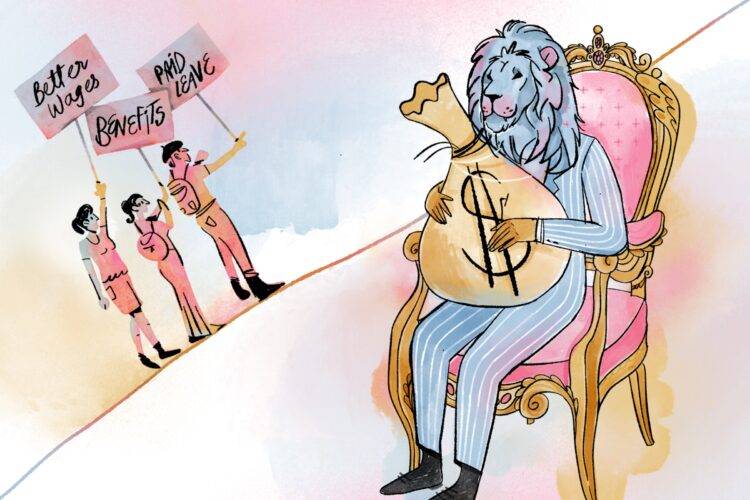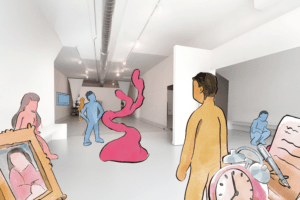
If you’ve found yourself outside the MacLean Building lately, you’ve probably seen representatives from the Art Institute of Chicago Workers United tabling. That’s our union. Or rather, unions — it’s technically a coalition of three bargaining units comprising staff at the AIC, staff at the School of the Art Institute of Chicago, and Non-Tenure Track faculty at SAIC.
That third unit, NTT, is still fighting for their first contract after 49 bargaining meetings with management. NTT faculty’s demands — including affordable health care and wages that reflect the cost of living in Chicago — should be given at all higher education institutions, especially those with financial statements and spending practices like SAIC’s.
AICWU is not unionizing or bargaining in a vacuum. Academic unions are not new; one of the earliest emerged from Black educators organizing at Howard University in 1918, marking a turning point in union organizing history. This time last year, the Columbia College Faculty Union initiated the 18th faculty union strike of 2023. The publication “In These Times” called it “The Longest Adjunct Strike in U.S. History.”
At Columbia College Chicago, where 72 percent of faculty are part-time instructors, the administration locked striking instructors out of online learning management systems and replaced their labor.
Rather than meeting the demands of the union, following the university’s announcement that they would be cutting over 300 courses during the 2023-2024 academic year, the administration asked full-time (non-union) faculty members to step in and teach the striking adjuncts’ classes. We have a word for those who are brought in to replace striking workers’ labor: scabs.
This tactic, in which striking labor is replaced by non-union labor, is used by administrators, managers, and bosses alike to pit workers against each other while simultaneously rendering specialized labor interchangeable and replaceable.
As we transition to further considering our own administration’s profiteering and bonus-driven decision-making, it is important to note that many of the part-time faculty at Columbia who participated in the 49-day strike last fall also teach at SAIC.
In the 2022 fiscal year, the combined salaries across the highest 22 earners at S/AIC amounted to $7,741,989. Including non-reportable compensation, this number rises to $8,682,836.
The wage gap between these administrators and the thousands of workers who make up S/AIC is untenable. If the president of the AIC, James Rondeau, who was paid $1,073,976 in 2022, was to work a 40-hour work week for an hourly wage, he would be making $516 per hour — including a paid lunch break (unlike many SAIC student workers). Rondeau should take a pay cut, and so should just about every other administrator in higher education and the arts.
If you are reading this, and didn’t realize that we had a ton of administrators sapping our financial resources, that’s probably deliberate. The lack of engagement and distance between students and administrators is a tactic that blurs the otherwise negligible value of administrative labor.
The SAIC employees students interface with most often are instructors, not administrators. We come to this institution for an education, and we receive that education from our teachers. We build relationships with them, we create work under their guidance, we take risks, and we fail and grow in their classrooms, with their syllabi.
Administrators, on the other hand, are significantly less visible. Administrators make themselves known to students primarily through the occasional speech at an event few attend, 15-min, pre-booked appointments, or an email asking us to fill out an ambiguous survey. But by locating their offices behind walls and elevator floors students are rarely on, administrators obfuscate their absurd proliferation — we have a Director of Campus Life, Dean of Student Affairs, Associate Dean of Student Affairs for Campus Life, Assistant Director of Campus Life, Dean of Student Life, you get the idea — and the absurd amount of our schools’ financial resources that they pour into their own pockets.
College administrators hold immense power within bargaining and subsequent negotiating. They are the deciding factor, the holdout, and the impetus for faculty going on strike. However, administrators continually shift the blame of strikes, and their inevitable impact on classes and students, back onto instructors.
AICWU’s 16 months of bargaining with SAIC admin is not the fault of NTT faculty but rather the refusal of administrators to recognize the immense disparities in pay, benefits, and respectability between themselves and their workers. Let’s get one thing clear: Asking for a liveable wage and health care doesn’t make you a villain. Denying your workers such basic necessities does.
It’s easy to say that unions are strategic, but beyond that, they enact the democratic decision-making that has been removed from higher education in recent decades. In the face of a parasitic administrative class, eager for “financial stability,” (read: profit at any cost, no matter the source) there is a mounting urgency for institutional accountability. Within the ecological system of the college campus, invariably vertical at SAIC, we are each other’s support systems and unions are an exercise of our collective power. Pay equity and democratic decision-making go hand in hand. As academic administrators perpetuate a climate of scarcity and austerity — cutting course loads, withholding health care benefits, and extracting more and more unpaid labor from their students, staff, and faculty — their salaries surge and the lines between administrators and their workforce of (supposedly) replaceable labor are cemented. It is a time-honored tradition in the exploitation of the many for the benefit of the few. Let us not be mistaken: optimize, capitalize, exploit, and obfuscate are our school’s actual core values.
Correction: The print edition included a typo stating that NTT was still fighting for their first contract after 449 bargaining meetings with management. This number is incorrect; there was 49 meetings with management.







